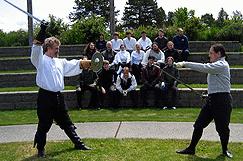|
The term Italian school of
swordsmanship is used to describe the Italian style of fencing and
edged-weapon combat from the time of the first extant Italian swordsmanship
treatise (1409) to the days of Classical Fencing (up to 1900). Although the
weapons and the reason for their use changed dramatically throughout these
five centuries, a few fundamental traits have remained constant in the
Italian school. Some of these are the preference for certain guards, the
preoccupation with time (or "tempo") in fencing as well as many of the
defensive actions. |
 |
|
Today, the Italian school of
swordsmanship is carefully preserved both in Italy and abroad. In Italy,
official fencing schools such as the National Academy (Accademia Nazionale)
certify masters in both historical fencing and modern fencing based on
careful adherence to the principles of Italian swordsmanship. Abroad, the
Italian style is cultivated by professional institutions such as the San
Jose State fencing program (California, USA), where Maestro William Gaugler
runs a program largely based on the Classical style of Parise.
The Historical European martial arts and the Western Martial Arts
communities in Europe and the United States have a large number of
researchers reconstructing the grappling, dagger, rapier, short sword, sword
& buckler, longsword, pollaxe, and spear systems of ancient masters. The
reconstruction efforts of these scholars give the martial arts community a
chance to learn fencing with full-size, full-weight weapons such as the
longsword, the single-handed sword, the spadone, the rapier and many others. |













